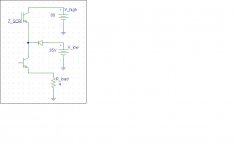Looking at a class G amplifier (class G = rail switching amp in my terminology) and the method used to switch from a low rail to a high rail, has anyone experimented with using an SCR as a switch? (See attached image for example)
In the attached schematic, the SCR would turn on when triggered by a control circuit once the audio signal approaches the low voltage rail limit. Once the high voltage rail is turned on, current flows from the high voltage rail.
==> In normal class G amps, the positive low voltage rail is switched back in service when the output voltage returns to the low voltage rail limit.
Using an SCR (and knowing that SCRs only turn off when current through them reaches ~0 amps), once the high voltage rail is turned on, it will continue to power the output transistors until the output voltage decreases and eventually reaches 0 (a zero crossing point in the music signal). During the next increase in voltage above 0, the low voltage rail would take over again.
I am relying on the fact that music signals are somewhat symmetrical over a period of time ==> if there is a large positive peak, then it will probably be followed by a large negative peak, and thus a zero crossing can safely be assumed.
Thoughts? Comments?
In the attached schematic, the SCR would turn on when triggered by a control circuit once the audio signal approaches the low voltage rail limit. Once the high voltage rail is turned on, current flows from the high voltage rail.
==> In normal class G amps, the positive low voltage rail is switched back in service when the output voltage returns to the low voltage rail limit.
Using an SCR (and knowing that SCRs only turn off when current through them reaches ~0 amps), once the high voltage rail is turned on, it will continue to power the output transistors until the output voltage decreases and eventually reaches 0 (a zero crossing point in the music signal). During the next increase in voltage above 0, the low voltage rail would take over again.
I am relying on the fact that music signals are somewhat symmetrical over a period of time ==> if there is a large positive peak, then it will probably be followed by a large negative peak, and thus a zero crossing can safely be assumed.
Thoughts? Comments?
Attachments
The major disadvantage of SCRs and triacs is that they take some time to turn on and they do it progressively but in a non-controllable latch-up-like way. Since switching slope control is very convenient for class G, MOSFETs and bipolar transistors are much better suited.
Also, half of the efficiency benefit and all the SOA advantages of class G would be lost if SCR were employed.
Also, half of the efficiency benefit and all the SOA advantages of class G would be lost if SCR were employed.
- Status
- This old topic is closed. If you want to reopen this topic, contact a moderator using the "Report Post" button.
